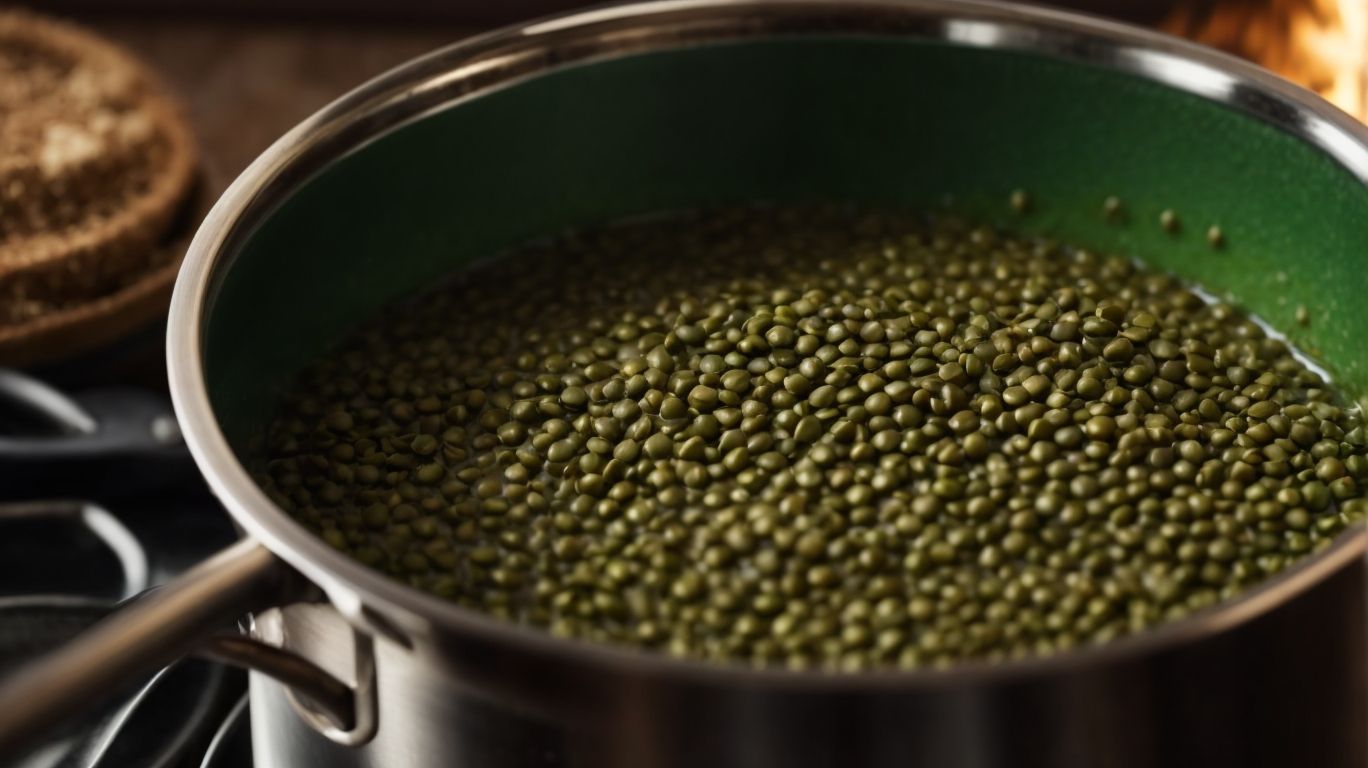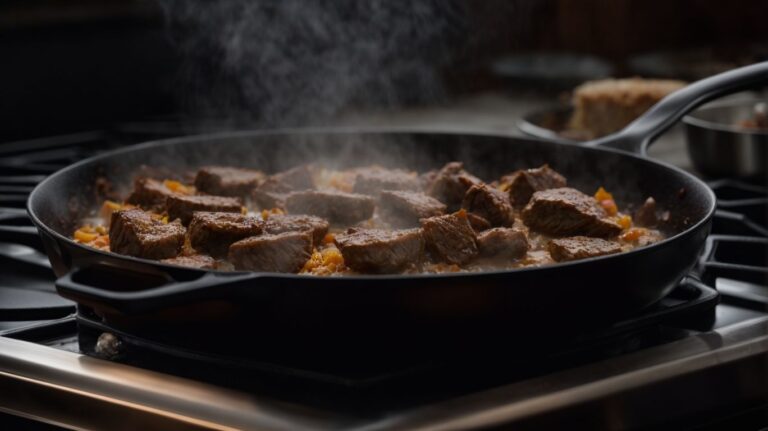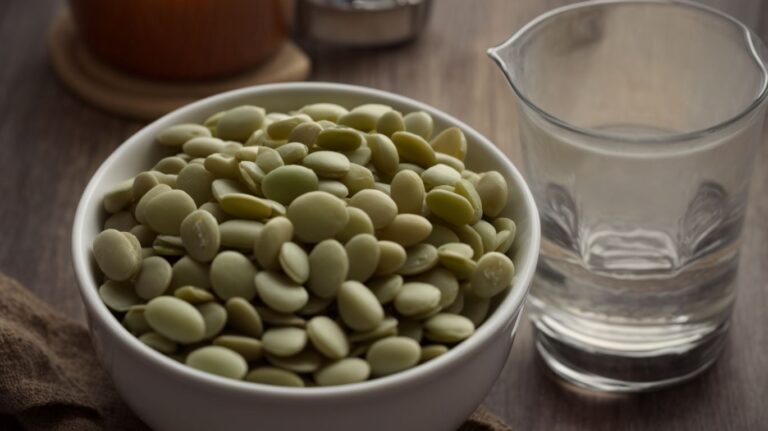How to Cook Green Lentils?
Looking to add a healthy and versatile ingredient to your cooking repertoire?
Green lentils are a great choice! Learn all about green lentils – their nutritional benefits, cooking methods, how to prepare, cook, and store them, and try some delicious recipes.
Dive into the world of green lentils and elevate your culinary creations!
Key Takeaways:
About Green Lentils
Green lentils, a versatile and nutritious legume, are a staple in vegetarian and plant-based cuisines, offering a wide range of culinary possibilities.
These small, lens-shaped legumes pack a powerful nutritional punch, being rich in protein, fiber, and essential minerals. The protein content of green lentils makes them a popular choice for those looking to boost their protein intake, especially in vegetarian diets. Green lentils are known for their earthy flavor and slightly peppery taste, adding depth to soups, salads, and stews. Their firm texture holds up well in dishes, making them a great choice for adding substance to vegetarian meals. When cooking green lentils, they typically take around 20-30 minutes to soften but should not become mushy.
What Are Green Lentils?
Green lentils, part of the legume family, are small lens-shaped seeds commonly used in diverse cuisines worldwide.
These earthy-flavored legumes are prized for their firm texture and nutty taste, making them perfect for salads, soups, stews, and side dishes. Green lentils retain their shape well even after cooking, which adds a delightful bite to various dishes. They come in different types such as French green lentils, also known as Puy lentils, and North American green lentils. French green lentils are favored for their peppery flavor and hold up well when cooked, ideal for salads, whereas North American green lentils are slightly larger and more commonly found in grocery stores. Both types are excellent sources of protein, fiber, and essential nutrients, making them a staple ingredient in vegetarian and vegan diets.
What Are the Nutritional Benefits of Green Lentils?
Green lentils are a rich source of plant-based protein, making them an excellent choice for vegetarian and vegan diets.
Green lentils are packed with essential nutrients such as iron, folate, and fiber, which are crucial for overall health and well-being. The protein content in green lentils helps in muscle repair and growth, making them a great alternative to meat for meeting daily protein needs. Including green lentils in your diet can aid in weight management, promote heart health, and support digestive function due to their high fiber content.
How to Prepare Green Lentils Before Cooking?
Before cooking green lentils, it is essential to properly rinse them to remove any debris and enhance their texture and flavor.
Next, soaking the green lentils is an important step that can greatly enhance the overall cooking process. By soaking the lentils for a few hours or overnight, you can improve their digestibility and reduce the cooking time significantly. This process also helps to soften the lentils, resulting in a more tender texture once cooked. When adjusting the cooking ratio, consider using high-quality ingredients such as fresh herbs, spices, and broth to elevate the flavor profile of the dish.
Do You Need to Soak Green Lentils Before Cooking?
While soaking green lentils is not mandatory, it can help reduce cooking time and improve their digestibility by softening the seeds.
By allowing the lentils to soak, you are kickstarting the cooking process, leading to a shorter overall cooking time. This is especially beneficial if you are short on time but still want to enjoy a wholesome meal. Soaking green lentils can alter their texture, making them more tender and palatable. It also aids in breaking down complex sugars, potentially making them easier on the stomach for some individuals.
When opting to soak green lentils, it is recommended to use a 1:3 ratio of lentils to water. Simply cover the lentils with water and let them sit for a minimum of 4 hours or preferably overnight. This gradual absorption of water results in plumper, evenly cooked lentils.
How to Properly Rinse Green Lentils?
Rinsing green lentils under cold water helps remove dirt and debris, ensuring a clean base for cooking and enhancing the dish’s overall texture and flavor.
It is essential to use cold water during rinsing as it helps retain the lentils’ firm texture and prevents them from becoming mushy when cooked.
By washing the lentils thoroughly, you are not only cleaning them but also removing any impurities that could alter the taste of your dish. Rinsing the lentils can play a crucial role in how they absorb the flavors of the stock or seasonings you add during cooking.
How to Cook Green Lentils?
Cooking green lentils can be done through various methods such as boiling, simmering, or pressure cooking, each offering unique flavor profiles and textures.
Boiling green lentils is a straightforward method that retains the lentils’ shape but can sometimes result in a slightly mushier texture. Simmering, on the other hand, allows for a more gentle cooking process, ensuring that the lentils are tender yet firm. Pressure cooking is a quicker method that can intensify the flavors of the lentils while preserving their natural taste.
When seasoning green lentils, experiment with herbs like rosemary, thyme, or bay leaves for earthy undertones. For a hint of spice, consider adding cumin, coriander, or smoked paprika. Combining aromatic ingredients such as garlic, onions, and carrots can enhance the overall depth of flavor in your lentil dishes.
What Is the Best Cooking Method for Green Lentils?
In terms of cooking green lentils, methods like simmering in soups or stews are popular choices that infuse the lentils with rich flavors and create hearty meals.
Simmering green lentils in soups or stews not only enhances their natural earthy taste but also allows them to soak up the delicious broth, making each bite flavorful and satisfying. To prepare your lentils for simmering, it’s essential to rinse them thoroughly and soak them beforehand to reduce cooking time and improve digestibility.
When seasoning your lentils, consider using aromatic spices like cumin, coriander, and smoked paprika to add depth to the dish. For a tangy twist, a squeeze of fresh lemon juice or a splash of vinegar can brighten up the flavors.
What Are Some Tips for Cooking Green Lentils Perfectly?
To cook green lentils perfectly, consider using flavorful stocks, incorporating meal prep techniques, and referring to recipe videos for inspiration and guidance.
In terms of enhancing the flavors of your green lentil dish, experiment with additions like fragrant herbs, aromatic spices, or a splash of citrus juice for a zesty kick.
Adjusting cooking times based on the desired texture is crucial – whether you prefer your lentils slightly firm for salads or mushier for soups, keep a close eye on them for that ideal consistency.
Incorporating best practices such as rinsing the lentils before cooking, using a wide pot to allow even cooking, and letting them rest after cooking for flavors to meld, guarantees a successful green lentil dish every time.
What Are Some Delicious Recipes Using Green Lentils?
Green lentils serve as a versatile ingredient in a variety of delectable dishes, including Green Lentil Soup, Green Lentil Salad, and Green Lentil Curry.
Their earthy flavor and hearty texture make them perfect for adding depth and substance to meals that are both nutritious and satisfying.
For a comforting bowl of Green Lentil Soup, start by sautéing onions, carrots, and celery in a pot until softened. Add in green lentils, vegetable broth, and seasonings like cumin and coriander. Let it simmer until the lentils are tender, and finish off with a squeeze of fresh lemon juice.
Green Lentil Salad is a refreshing option, combining cooked lentils with diced cucumbers, cherry tomatoes, feta cheese, and a zesty vinaigrette dressing. Top it off with some fresh herbs like parsley or mint for an extra burst of flavor.
When craving something spicy and aromatic, whip up a Green Lentil Curry. Sauté garlic, ginger, and spices like turmeric, cumin, and garam masala in a pan, then add green lentils, coconut milk, and tomatoes. Let it simmer until the flavors meld together beautifully, and serve over fluffy rice or with warm naan bread.
Green Lentil Soup
Green Lentil Soup is a hearty and nutritious dish that combines the earthy flavors of lentils with aromatic spices and savory seasonings.
It’s a versatile soup that can be customized to suit different taste preferences and dietary needs. To make this delicious soup, start by sautéing onions, garlic, and carrots in a splash of olive oil until they are tender and fragrant. Then, add in the green lentils and vegetable broth, bringing the mixture to a gentle simmer.
Once the lentils are tender, season the soup with a pinch of cumin , coriander, and smoked paprika for a warm and robust flavor profile. For added freshness, stir in a handful of chopped parsley and a squeeze of lemon juice just before serving.
Green Lentil Salad
Green Lentil Salad is a refreshing and vibrant dish that combines cooked lentils with fresh vegetables, zesty dressings, and optional toppings for added texture.
For a nutritious twist, consider pureeing some of the green lentils to create a creamy base for the salad, adding a rich texture and extra protein. Sprouted green lentils can also be a delightful addition, offering a crunchy element and enhanced nutrient profile.
When selecting ingredients, opt for colorful vegetables like cherry tomatoes, bell peppers, and cucumber to add visual appeal and a variety of flavors. Pair the salad with a tangy vinaigrette or a creamy tahini dressing for contrasting tastes.
To elevate the dish further, incorporate fresh herbs like parsley or cilantro for a burst of freshness, or toasted nuts and seeds for crunch. Serve the green lentil salad chilled as a main course or as a side dish with grilled proteins for a satisfying meal.
Green Lentil Curry
Green Lentil Curry is a fragrant and flavorful dish that brings together aromatic spices, creamy lentils, and traditional seasonings for a delightful culinary experience.
Originating in the Indian subcontinent, lentil curries have a rich history dating back centuries, with each region adding its own unique twists to the recipe. The blend of cumin, coriander, turmeric, and garam masala creates a symphony of flavors in this dish. To achieve the perfect consistency, it’s essential to cook the lentils until they are tender but not mushy, allowing them to absorb the spices’ essence. Balancing the heat of chili peppers with the creaminess of coconut milk or yogurt adds a delightful contrast that harmonizes the dish’s overall taste.
How to Store Leftover Green Lentils?
Properly storing leftover cooked green lentils is essential for preserving their quality and flavor, whether in the fridge or freezer.
After cooking green lentils, cool them completely before storing. For short-term storage in the fridge, transfer the lentils into an airtight container or a resealable bag. This helps prevent any moisture loss or absorption, maintaining their texture and taste. Label the container with the date to track freshness. To freeze, portion out the lentils into smaller quantities for easier thawing and reheating. Use freezer-safe containers or bags and remove excess air to prevent freezer burn. Thaw frozen lentils in the fridge overnight before reheating.
When reheating cooked lentils, consider adding a splash of water or broth to maintain moisture, preventing them from becoming dry. Utilize a microwave-safe dish for quick reheating or gently warm them in a saucepan on the stovetop. For added flavor, incorporate herbs, spices, or a drizzle of olive oil.
- Store leftover lentils in glass containers to avoid any transfer of odors.
- Repurpose leftover lentils in soups, salads, wraps, or casseroles for an easy meal prep option.
Can You Freeze Cooked Green Lentils?
Freezing cooked green lentils is a convenient way to preserve their freshness and versatility for future use in various recipes and meal preparations.
When freezing cooked green lentils, it’s essential to allow them to cool completely before packaging. This helps prevent condensation in the storage container, which can affect the texture of the lentils.
Opt for airtight containers or resealable freezer bags to minimize the risk of freezer burn. Make sure to label the containers with the date of freezing to keep track of their freshness.
In terms of thawing, place the frozen lentils in the refrigerator overnight for a gradual thawing process that maintains their taste and texture.
How Long Do Cooked Green Lentils Last in the Fridge?
Cooked green lentils can typically last in the fridge for up to 4-5 days when stored properly in airtight containers or sealed bags to preserve their flavor and texture.
When storing cooked green lentils in the fridge, it’s essential to ensure they are completely cooled down before refrigeration to prevent bacterial growth. Opt for glass or plastic containers with tight-fitting lids to maintain freshness and prevent any potential odors from seeping in.
To enhance their versatility, consider seasoning the lentils with a variety of herbs and spices before refrigeration. This can impart rich flavors that deepen over time, making the lentils ideal for quick meal prep. When reheating, adding a splash of broth or a drizzle of olive oil can help restore moisture and enhance the dish’s taste.
Frequently Asked Questions
What are green lentils and how do you cook them?
Green lentils are a type of legume that are high in protein and essential nutrients. They have a mild, nutty flavor and hold their shape well when cooked, making them great for salads, soups, and more. To cook green lentils, start by rinsing them in a strainer and then cooking them in a pot of water for about 20-25 minutes, or until tender.
What is the best way to season green lentils?
Green lentils can be seasoned in a variety of ways, depending on your personal taste and the dish you are making. For a basic seasoning, you can add salt, pepper, and a few cloves of garlic to the pot while cooking. You can also use herbs and spices such as cumin, coriander, and turmeric to add more flavor to your lentils.
How do you know when green lentils are fully cooked?
To test if your green lentils are fully cooked, take a spoonful out of the pot and taste it. It should be tender, but not mushy. If it is still hard, continue cooking for a few more minutes. You can also check the package instructions for a recommended cooking time, as different varieties of lentils may have different cooking times.
Can you cook green lentils in a slow cooker?
Yes, you can cook green lentils in a slow cooker. Simply add the lentils and water or broth to the slow cooker and cook on low for 4-6 hours, or on high for 2-3 hours. You can also add any desired seasonings and vegetables to the slow cooker for a complete one-pot meal.
Are there any health benefits to cooking and eating green lentils?
Yes, there are many health benefits to cooking and eating green lentils. They are high in fiber, protein, and essential nutrients such as iron and folate. They are also low in fat and calories, making them a healthy option for those looking to maintain a balanced diet.
What are some creative ways to use cooked green lentils?
Cooked green lentils can be used in a variety of dishes, from salads and soups to burgers and tacos. You can also use them as a healthy substitute for meat in dishes such as chili or bolognese. They can also be added to grain bowls or used as a filling for stuffed vegetables. The possibilities are endless!




